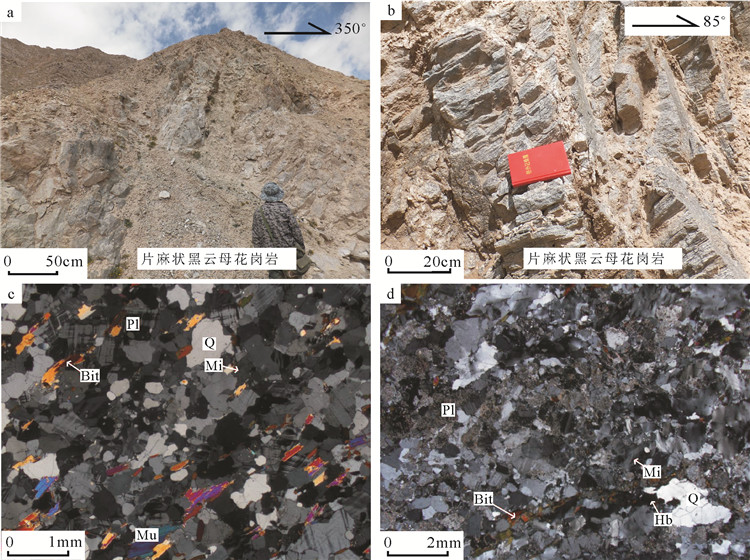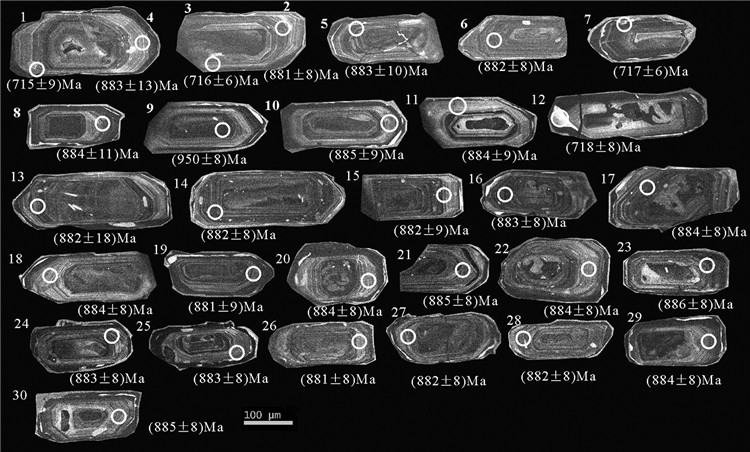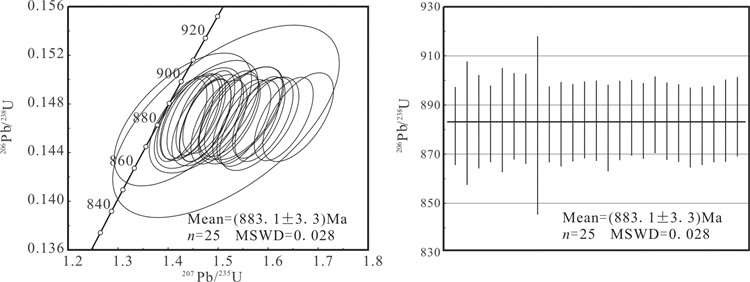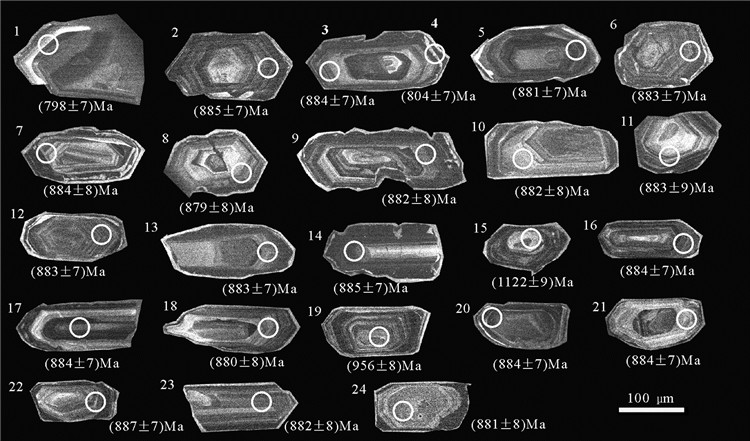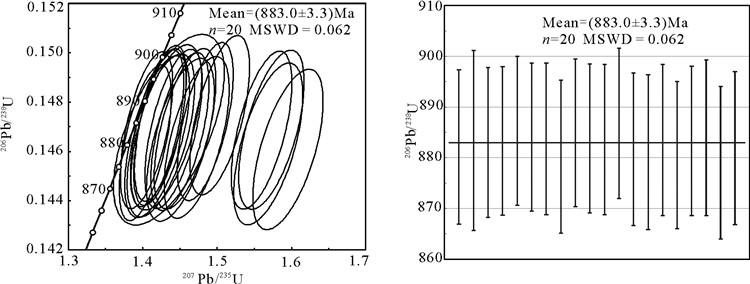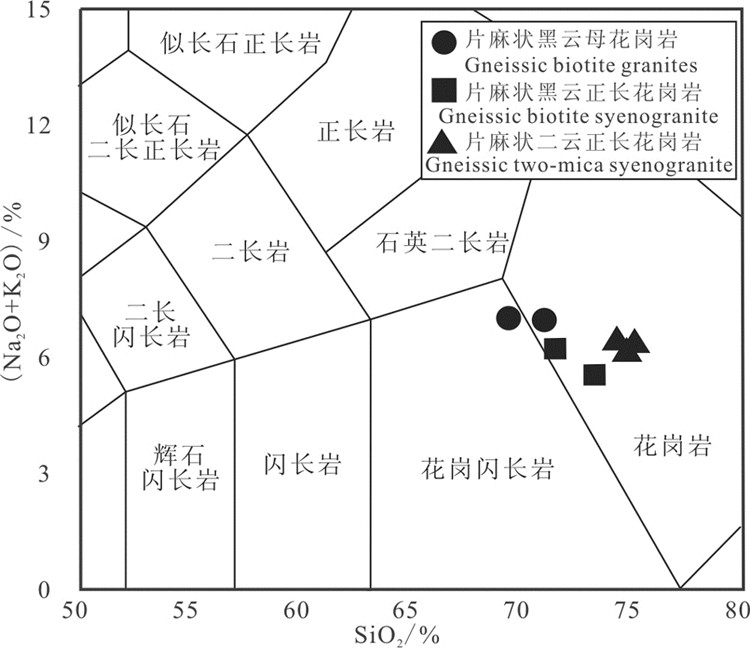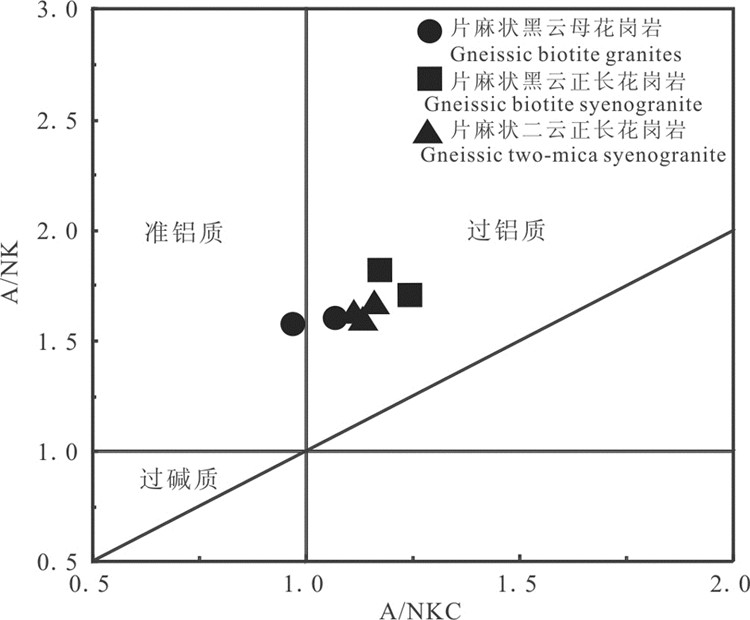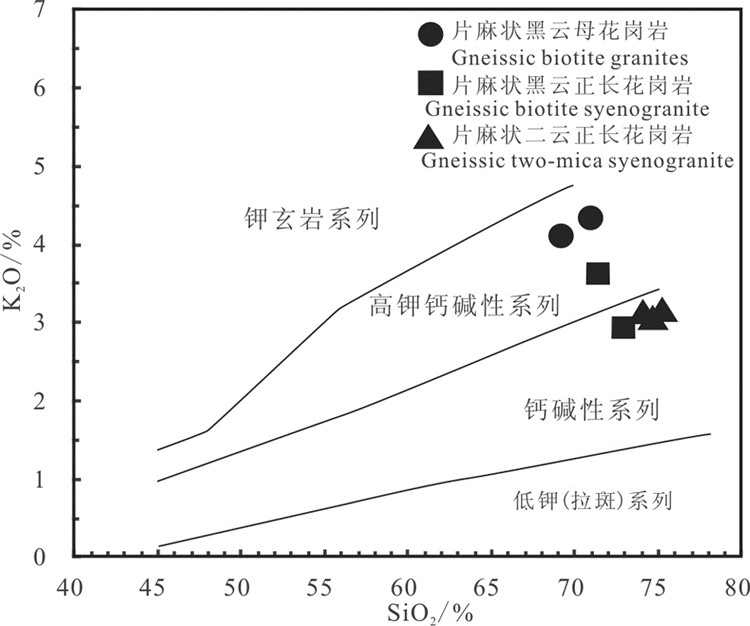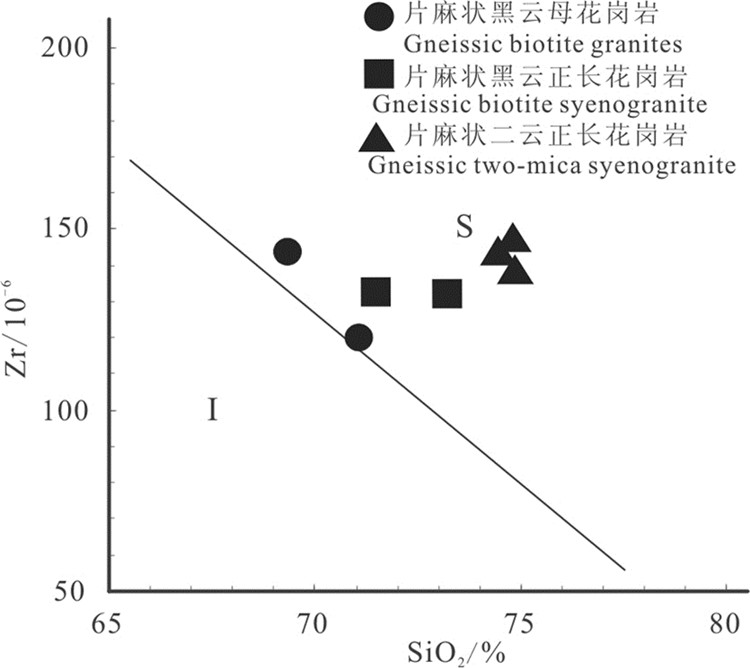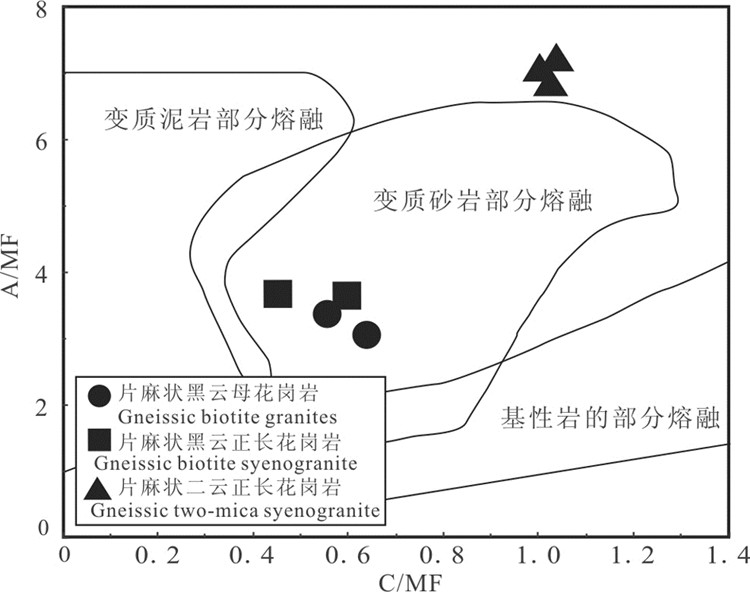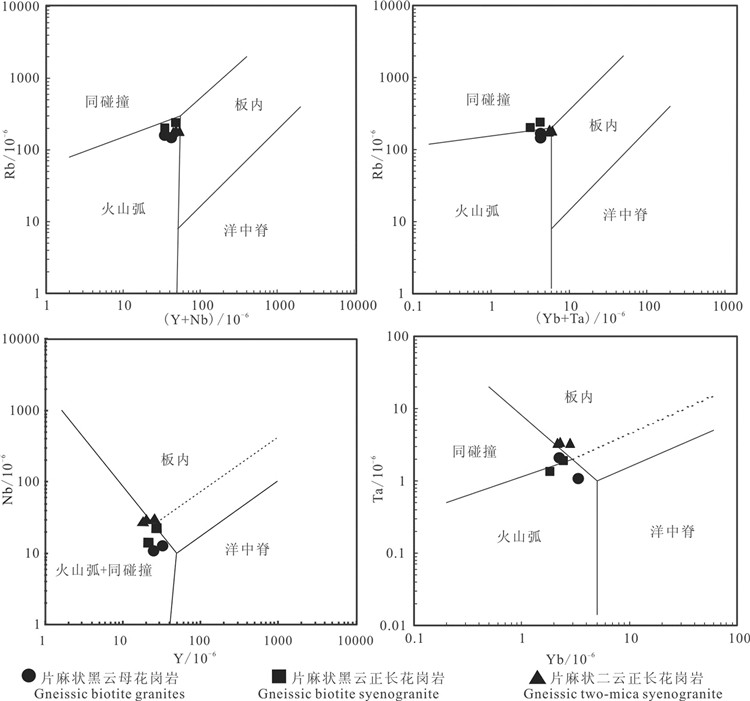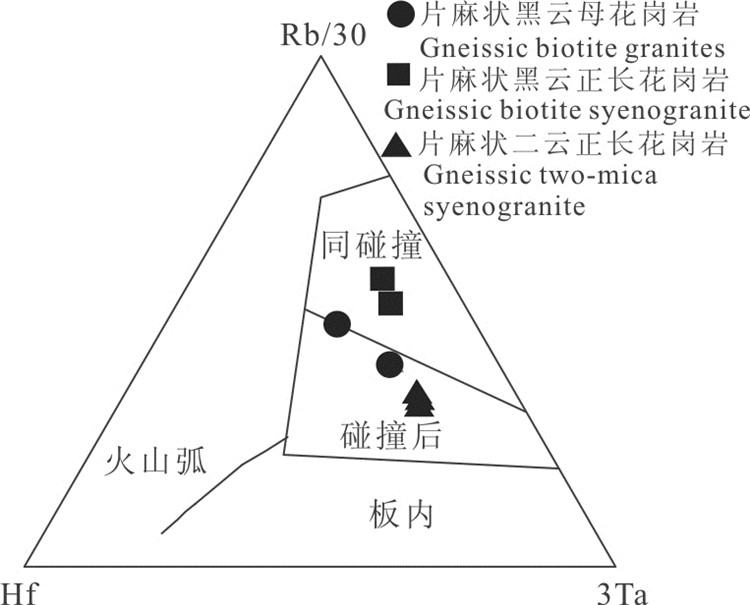Confirmation of gneissic granite of Qingbaikou period and its constraint on the timing of the Rodinia supercontinent on the Altun orogenic belt
-
摘要:
阿尔金造山带新元古代花岗岩的研究对探讨该地区Rodinia超大陆汇聚阶段构造演化过程具有重要意义。本文对在亚干布阳一带新厘定的青白口纪片麻状花岗岩开展了详细的岩石学、年代学和岩石地球化学研究。锆石LA-ICP-MS U-Pb年代学证据显示片麻状花岗岩结晶年龄分别为(883.0±3.3)Ma和(883.1±3.3)Ma,说明其侵位于青白口纪。地球化学结果显示,常量元素具有富硅、铝、钾和低钠、镁、钙和钛的特点,具钙碱性-高钾钙碱性、过铝质花岗岩特征。岩石轻稀土分馏较强而重稀土分馏较弱,具有明显的负Eu异常,总体呈右倾的“V”型稀土分配模式。岩石富集Rb、Th、LREE等大离子亲石元素,中等亏损Ba,强烈亏损Nb、Sr、P、Hf、Ti等高场强元素,总体特征显示了典型的壳源花岗岩的特征,其源于地壳变质砂岩部分熔融,形成于同碰撞晚期构造环境,属Rodinia超大陆汇聚阶段的产物。综合研究表明,阿尔金地区新元古代早期同碰撞型岩体的形成时代集中在871~945 Ma,限定了Rodinia超大陆汇聚时限,且在空间上构成了一条重要的岩浆岩带,是对Rodinia超大陆碰撞汇聚作用的响应。
-
关键词:
- 片麻状花岗岩 /
- LA-ICP-MS锆石U-Pb定年 /
- 地球化学 /
- 构造环境 /
- Rodinia超大陆 /
- 地质调查工程 /
- 阿尔金
Abstract:The study of the Neoproterozoic granites in the Altun orogenic belt is significant for revealing the area of the Rodinia supercontinent convergent stage tectonic evolution. In this paper, a detailed study of petrology, chronology and geochemistry was carried out for a new division of Qingbaikou gneissic granite in Yaganbuyang area. The U-Pb dating of zircons from the gneissic granite using LA-ICP-MS yielded (883.0±3.3)Ma and (883.1±3.3)Ma, indicating that the gneissic granite was generated in Qingbaikou period. The geochemical analysis shows that major elements are characterized by high SiO2, Al2O3 and K2O values and low Na2O, MgO, CaO and TiO2 values, thus belonging to the calc-alkaline-high-K calc-alkaline series, and peraluminous.REE distribution patterns show negative anomaly of Eu, obvious fractionation of LREE and weak fractionation of HREE, with a clear V trough, which shows the features of crustal derived granite. The gneissic granite is rich in large ion lithophile elements of Rb, Th, LREE, slightly depleted in Ba and mightily depleted in high field strength elements of Nb, Sr, P, Hf, Ti. These characteristics are similar to features of the continental collision type granite. The source rock of the gneissic granite was formed by the partial melting metasandstone from the crust in the subduction-collisional environment about Rodinia supercontinent. Comprehensive study shows that these syn-collisional granites were generated between 871 Ma and 940 Ma, which constrained the timing of the Rodinia supercontinent in Early Neoproterozoic along the Altun orogenic belt. These rock bodies have the characteristics of zonal distribution in space and confirm the existence of syn-collisional granites belt about Rodinia supercontinent on the Altun orogenic belt.
-
1. 引言
地下水中的化学成分可以示踪地下水的循环途径, 反映地下水流系统的特征;而地下水水化学类型是地下水化学成分的集中反映,也是地下水水文地球化学特征研究的重要内容之一(袁道先,1990;沈照理和王焰新,2002;王焰新等,2005)。水文地球化学结合同位素示踪的方法可更深入研究区域地下水的循环特征和水动力场特征(刘文波等,2010;李向全等,2011;郭晓东等,2014;袁建飞等,2016;孙厚云等,2018)。晋祠泉出露于太原西山悬瓮山下,由难老泉、圣母泉、善利泉组成,1954—1958年实测泉水平均流量为l.94 m3/s。与晋祠泉同处太原西山山前断裂带的平泉,1978年建立了特大型岩溶水自流井水源地,自流量最大达到1.56 m3/s。由于这些自流井的开采,使晋祠泉的流量急剧下降,1994年4月30日断流。为建设美丽山西,省政府将规划实施晋祠泉复流工程。因此研究晋祠泉的补给来源、晋祠—平泉水力联系成为一项重要课题。
2. 研究区概况
山西太原晋祠泉域位于太原盆地的北部,泉域面积2713 km2(梁永平等, 2019)。其碳酸盐岩含水层为下古生界寒武系和奥陶系,连续沉积厚度超过900 m。晋祠岩溶地下水主要接受西山碳酸盐岩裸露区及覆盖区的降水人渗补给、汾河及支流在碳酸盐岩段的渗漏补给(后期又加入水库渗漏补给)。晋祠泉域岩溶地下水排泄方式主要包括:晋祠泉、平泉、通过西山边山断裂带向盆地内松散层的潜流排泄以及人工开采井。晋祠泉位于北北东向晋祠断裂之南端,位于岩溶发育的排泄区,为西山岩溶地下水的天然集中排泄点,断裂西侧出露有奥陶系峰峰组石灰岩,断裂东侧为第四系松散层,岩溶地下水向东遇第四系松散层的阻挡而沿断裂上升溢出地表形成泉水(图 1)。晋祠泉群泉总流量在20世纪50年代平均为1.95 m3 /s,60年代为1.61 m3 /s,70年代为1.21 m3 /s,80年代为0.52m3/s(晋华等, 2005)。1960年以前基本上为天然动态。平泉则位于交城至清徐的北东东向断裂带之北端,晋祠泉的下游,是西山岩溶地下水的人工排泄点之一,泉水出露高程为784.31~86.87 m。2011年8月,清徐县平泉村“不老泉”和沙河底“水巷”两处泉水呈现复流迹象。2016—2018实测群泉总流量分别为0.067 m3/s、0.084 m3/s、0.114 m3/s。
3. 研究技术与方法
通过开展野外地质、水文地质补充调查,查明晋祠、平泉水文地质条件。于2016年5月在晋祠泉域边山断裂带取样24组。其中简分析9组,全分析15组(表 1)。2016年5月—2018年5月布置水质长观点两处,分别为晋祠泉口岩溶井、平泉村不老池泉水。pH、温度、电导率等指标直接通过WTW多功能水质监测仪现场测试获得;Ca、HCO3离子由德国默克测试盒现场滴定。化学分析在中国地质科学院岩溶地质研究所国土资源部重点实验室完成。2H/18O同位素(中国地质科学院岩溶地质研究所国土资源部重点实验室)测定精度分别为±2.0‰和±0.1‰;δ34S值在中国地质调查局武汉地质调查中心实验室完成测试,δ34S值采用IsoPrime质谱仪进行测定,δ34S值采用CDT(Canyon Diablo Meteorite)标准,测试精度优于±0.1‰。所有水样阴阳离子平衡相对误差小于5%,利用水化学模拟软件Phreeqc计算矿物饱和指数;利用Origin软件绘制离子比例系数图、同位素分析。
表 1 取样点基本信息Table 1. The information of sampling point
4. 晋祠—平泉水力联系分析
4.1 水位动态特征
地下水位动态变化,是反映含水层中地下水资源量变化的一个指征,地下水位的上升或下降,直接反映了地下水补给与消耗量的变化(陶虹等, 2013)。根据地下水水位动态监测资料分析,在1980年前,地下水水位的变化随降水量的大小而变化,呈稳定状态(图 2);1980—1992年,晋祠泉地下水水位的变化呈稳定下降趋势,主要原因是有太原化学工业公司、开化沟、淸徐县平泉村和梁泉村等水源地大量开采岩溶地下水,导致地下水水位下降;1993—2005年,整个泉域地下水水位急剧下降,主要原因是岩溶水开采量急剧加大和降水量减少(图 3);2005—2012年,泉域地下水水位呈上升趋势,主要原因是万家寨引黄工程,“关井压采”,部分工矿企业置换利用黄河水,中小煤矿整治与关停,汾河实施清水复流工程(二库修建),使泉域内岩溶地下水水位有明显回升(图 2)。
![]() 图 3 晋祠泉流量与岩溶水开采量变化趋势对比曲线(a)及晋祠泉—平泉流量关系线(b),资料来源山西省第一水文地质工程地质队;1—晋祠泉流量;2—晋祠泉域岩溶地下水开采量;3—平泉流量Figure 3. Comparison curve of Jinci spring discharge and karst water exploitation(a) and the discharge relation between Jinci spring versus Pingquan spring(b)1-Jinci spring flow; 2-Karst groundwater exploitation in Jinci spring area; 3- Pingquan spring flow
图 3 晋祠泉流量与岩溶水开采量变化趋势对比曲线(a)及晋祠泉—平泉流量关系线(b),资料来源山西省第一水文地质工程地质队;1—晋祠泉流量;2—晋祠泉域岩溶地下水开采量;3—平泉流量Figure 3. Comparison curve of Jinci spring discharge and karst water exploitation(a) and the discharge relation between Jinci spring versus Pingquan spring(b)1-Jinci spring flow; 2-Karst groundwater exploitation in Jinci spring area; 3- Pingquan spring flow4.2 水化学特征
岩溶水化学成分受区域内的地质条件、水动力条件和人类工程活动等因素的控制,并能够较好的保存这种影响“信息”。因此,水文地质工作者经常利用水文地球化学方法研究复杂的岩溶水系统(Smykatz-Kloss et al., 1990; Fairchild et al., 2006; Musgrove et al., 2010; Rui Ma et al., 2011;唐春雷等,2019)。依据工作所取得岩溶地下水,碎屑岩井水样分析结果,得出岩溶水pH值6.92~7.86,均值为7.35。钙离子95.3~417.0 mg/L,均值为226.9 mg/ L。硫酸根离子149~1219 mg/L,均值为633 mg/L。碎屑岩井水30.5~73.1 mg/L,均值为60.0 mg/L。硫酸根离子35~90 mg/L,均值为66 mg/L。岩溶水(泉)总体特征表现为阳离子高钙镁、低钾钠,阴离子低氯,高硫酸根。按照舒卡列夫分类法,研究区碳酸盐岩含水岩组地下水主要类型是Ca-SO4型与Ca-SO4·HCO3型。其中Ca-SO4·HCO3型主要分布在西山断裂带北部。Ca-SO4型主要分布在西山断裂带南部。碎屑岩井地下水主要类型是Ca · NaHCO3型。晋祠泉、平泉同为Ca-SO4型(表 2)。
表 2 晋祠泉域岩溶地下水水化学类型Table 2. Karst groundwater hydrochemical type of Jinci spring catchment
研究区岩溶地下水化学组分主要受方解石(文石)、白云石和石膏等矿物影响。SO42-+ HCO3-与Ca2++Mg2+关系图(图 4a)显示,岩溶地下水样品呈直线分布并偏离至1:1线以下,表明少量有煤矿排水,地表水的混入岩溶地下水中。Na++K+-Cl与Ca2++ Mg2+ - SO42-- HCO3-关系图(图 4b)显示,径流区部分点位于阳离子交换线附近,说明地下水水化学形成除方解石(文石)、白云石和石膏的溶解,还有阳离子交换作用。
![]() 图 4 龙子祠岩溶地下水离子关系图a—(SO4+ HCO3)-(Ca2++Mg2+)图; b—(Na++K+-Cl-)-(Ca2++Mg2+-SO4-HCO3)图; c—SO42+ -TDS图; d—Sr2+ -Ca2+图; 1—晋祠泉;2—平泉;3—碎屑岩井;4—岩溶井Figure 4. Ion relation diagrams of karst groundwater in Longzicia-(SO4+ HCO3)versus(Ca2++Mg2+); b-(Na++K+-Cl-)versus(Ca2++Mg2+-SO4-HCO3); c-SO42+ versus TDS; (d-Sr2+ versus Ca2+; 1-Jinci spring; 2-Pingquan spring; 3-Clastic rock well; 4-Karst well
图 4 龙子祠岩溶地下水离子关系图a—(SO4+ HCO3)-(Ca2++Mg2+)图; b—(Na++K+-Cl-)-(Ca2++Mg2+-SO4-HCO3)图; c—SO42+ -TDS图; d—Sr2+ -Ca2+图; 1—晋祠泉;2—平泉;3—碎屑岩井;4—岩溶井Figure 4. Ion relation diagrams of karst groundwater in Longzicia-(SO4+ HCO3)versus(Ca2++Mg2+); b-(Na++K+-Cl-)versus(Ca2++Mg2+-SO4-HCO3); c-SO42+ versus TDS; (d-Sr2+ versus Ca2+; 1-Jinci spring; 2-Pingquan spring; 3-Clastic rock well; 4-Karst well在TDS是反映水质的综合指标。研究区TDS与硫酸根含量存在着极高的线性相关(图 4c)。区域岩溶地下水中SO42-主要来源有奥陶系碳酸盐岩含水层石膏溶解,煤矿酸性水和大气降水中的硫酸根(张海潇等, 2019)。说明含水层石膏溶解,煤矿酸性水补给,大气降水中的硫酸根是影响TDS的主要因素之一。
岩溶水循环过程中,Sr2+浓度随着径流途径和水岩交互作用的时间而增加,相比之下Ca2+浓度却受制于溶解平衡,因此,不同来源的水的Sr2+/Ca2+值不同,径流途径和水岩交互作用的时间越长,其值越大,反之越小(Keul et al., 2017; Yokota et al., 2018; Pracný et al., 2019)。如图 4(d)所示岩溶水径流区(晋祠泉J17,J24,J13,J19,J18,J21,J20),排泄区(平泉,J04,J11,J10,J12,J01,J07),热水井(J16,J15) Sr2+浓度随着径流途径增加。热水井(J16,J15)Sr2+浓度最高,其原因是水岩交互作用的时间较长。
4.3 同位素环境特征
δ34S-SO42-被广泛用于追踪水中硫酸盐的来源氢(Temovski et al., 2018; Xiao et al., 2018; Zhou et al., 2018; Sim et al., 2019)。氢氧同位素是研究地下水起源与演化的理想示踪剂,可利用地下水中的稳定氢氧同位素识别研究区地下水补给来源(Schiavo et al., 2009; Capaccioni et al., 2011; Pasvanoğlu, 2013; Zhang and Li, 2019)。晋祠泉—平泉段岩溶地下水的δ18O变化在-9.7‰~-8.5‰,δD变化在-70.1‰~-63.9‰,平均值分别为-9.3‰和-68.4‰。,该段岩溶水样点均散落于太原站大气降水线右下方(图 5a),表明其主要补给来源为大气降雨。晋祠—平泉一带岩溶地下水氢氧同位素值较接近,说明这一带补给来源与补给途径相近。
地下水中硫酸盐主要有3种来源,即降水、蒸发岩溶解和硫化物或有机硫氧化。在水文地球化学研究中,常使用δ34S对水中硫酸盐的来源进行标定。大量研究表明,山西中奥陶统石膏的δ34S值为23.8‰ ~31.4‰,矿坑水中的δ34S值为- 13.6% ~ 7.98‰,新近系黄土中δ34S值为5.5‰~9.5‰,汾河及其支流与引黄水的中δ34S值7.9‰~10.66‰。从晋祠泉—平泉段岩溶水δ34S分布图(图 5b),可以看出,岩溶地下水的δ34S值总体较大,接近于石膏的δ34S值范围,说明岩溶地下水中的SO42-主要来源于石膏溶解。
4.4 晋祠—平泉水化学水质监测分析
为了分析晋祠—平泉水力联系的水化学证据,在晋祠难老泉、不老池开展了逐月水化学含量动态监测(Ca2+、Mg2+、K++Na+、Cl-、SO42-、NO3-)。2016年5月至2018年5月共50组水样,如图 6所示晋祠泉与平泉各个离子变化趋势基本一致。说明晋祠与平泉存在紧密的水力联系。平泉Ca2+、Mg2+、SO42-、K++Na+含量显著高于晋祠泉,而Cl-、NO3-含量则低于晋祠泉。
4.5 径流途径水化学演化
反向地球化学反应路径模拟是定量研究水文地球化学演化的重要手段。反应路径模拟的理论基础是沿地下水同一水流路径,终点的水化学成分和同位素的质量等于起点的水化学成分和同位素的质量加上两点间由于水岩作用(如沉淀、溶解、阳离子交换等)、蒸发作用和不同水流的混合作用引起的化学组分和同位素的转移量,通过质量平衡反应模型和同位素质量传输模型,可推测地下水从起点到终点间的水文地球化学反应路径(Plummer et al., 1990; Petalas and Lambrakis, 2006; Han et al., 2011; Cánovas et al., 2016)。
4.5.1 饱和指数与可能矿物相的确定
饱和指数能反映常见的含有碳酸盐类、硫酸盐类和硅酸盐类等矿物与地下水之间所处的溶解平衡状态,这是反向水文地球化学模拟计算的基础。利用Phreeqc计算各矿物饱和指数(表 3),由表 3可以看出:方解石、文石、白云石的饱和指数均大于0,说明它们在地下水中呈饱和状态,具有沉淀趋势;石膏、硬石膏和岩盐的饱和指数均小于0,说明它们在地下水中处于非饱和状态,具有继续溶解趋势。依据饱和指数分析结果,选择石膏、方解石、白云石、NaCl,作为水文地球化学模拟的“可能矿物相”。
表 3 岩溶地下水中矿物饱和指数Table 3. Mineral saturation index in karst groundwater
4.5.2 Phreeqc水化学模拟
应用Phreeqc软件确定了水中各种组分和矿物的饱和状态;通过物质平衡模型,来确定岩溶地下水系统径流路径上不同两点之间矿物沉淀或溶解的数量。晋祠—平泉径流路径发生的主要水岩作用为:石膏的溶解,方解石沉淀、岩盐稀释和二氧化碳气体溶解或逸出等。
5. 对晋祠泉复流的贡献
晋祠泉与平泉同属于一个晋祠泉岩溶地下水系统,都位于西山山前边山断裂带的排泄区。晋祠与平泉存在紧密的水力联系。说明晋祠泉与平泉存在一个比较强的导水通道。可以通过在晋祠泉下游导水通道上帷幕灌浆,提高晋祠泉水水位,使晋祠泉出流。此方案的优点:(1)晋祠泉水水质明显优于平泉。(2)降低下游带压煤矿开采突水的风险。(3)晋祠泉水出流以地表水渠形式管理调度,生态人文环境影响较小。
6. 结论
(1) 在1980年前,晋祠泉地下水水位的变化随降水量的大小而变化,呈稳定状态;1980—1992年,地下水水位的变化呈稳定下降趋势,主要原因是大量开采岩溶地下水;2005—2012年,地下水水位呈上升趋势,主要原因是万家寨引黄工程,关井压采,部分工矿企业置换,汾河实施清水复流工程(二库修建),使泉域内岩溶地下水水位有明显回升。
(2) 研究区碳酸盐岩含水岩组地下水主要类型是Ca-SO4型、Ca-SO4·HCO3型。Ca-SO4·HCO3型主要分布在西山断裂带北部。Ca-SO4型主要分布在西山断裂带南部。碎屑岩井地下水主要类型是Ca·Na-HCO3型。晋祠泉、平泉同为Ca-SO4型。
(3) 晋祠泉的δ18O和δD值分别为- 9.39‰,- 68.5‰。平泉的δ18O和δD值分别为- 9.29‰,-71.0‰。其点均散落于太原站大气降水线右下方,表明晋祠泉与平泉的主要补给来源为大气降雨,氢氧同位素值较接近,说明晋祠泉与平泉补给来源与补给途径相近。研究区岩溶地下水的δ34S值总体较大,接近于石膏的δ34S值范围,说明岩溶地下水中的SO42-主要来源于石膏溶解。
(4) 晋祠与平泉存在紧密的水力联系,晋祠泉与平泉存在一个比较强的导水通道。可以通过帷幕灌浆,提高晋祠泉水水位,使晋祠泉出流。
致谢: 中国地质调查局西安地质调查中心校培喜教授级高级工程师和西北大学刘良、柳小明教授在论文写作过程中提供了建设性意见, 谨此表示感谢。 -
图 1 阿尔金造山带大地构造位置图(a)及研究区地质简图(b)
TRB—塔里木盆地;QL—祁连山;QDB—柴达木盆地;WKL—西昆仑;EKL—东昆仑;HMLY—喜马拉雅山;INP—印度板块;Q—第四系;N2y—新近系油砂山组;J1-2dm—侏罗系大煤沟组;ЄOMm—奥陶纪茫崖蛇绿混杂岩;QbS—青白口系索尔库里群;Pt1A—古元古代阿尔金岩群;O—S玉苏普阿勒塔格岩体;O2-3—帕夏拉依档岩体;νQb—斜长角闪岩;γQb—片麻状花岗岩;γδQb—盖里克片麻岩;γδοQb—亚干布阳片麻岩;OΣH—超基性岩块体;β—玄武岩块体;v—辉长岩脉
Figure 1. Tectonic position map of Altun (a) and geological sketch map of the study area (b)
TRB-Traim Basin; QL-Qilian Mountains; QDB-Qaidam Basin; WKL-Western Kunlun Mountains; EKL-Eastern Kunlun Mountains; HMLYHimalaya Mountains; INP- Indian Plate; Q- Quaternary; N2y- Neogene Youshashan Formation; J1-2dm- Jurassic Dameigou Formation; ЄOMm - Ordovician Mengya ophiolite melange; QbS- Qingbaikou System Suorkuli Group; Pt1A- Palaeoproterozoic Altun rock group; O- S- Yusupualeke Tagh plutons; O2-3-Paxialayidang plutons; νQb-Amphibolite; γQb-gneissic granite; γδQb-Gailike plutons; γδοQb -Yaganbuyang syenogranite; OΣH-Ultrabasic rock block; β-Bsaltic Block; v-Gabbro dyke
图 2 片麻状花岗岩野外宏观特征及显微镜下照片
a、b—片麻状黑云花岗岩宏观露头照片;c、d—片麻状黑云母花岗岩显微照片(c—PM004/6-1Bb,正交偏光;d—PM003/4-1Bb,正交偏光);Pl—斜长石;Mi—微斜长石;Q—石英;Bit—黑云母;Mu—白云母;Hb—角闪石
Figure 2. The outcrop and microstructure photos of gneissic granite
A, b-The outcrop photos of gneissoid-biotitic granite; c-Micro-photos of gneissoid-biotitic granite (PM004/6-1Bb, crossed nicols-PM003/4-1Bb, crossed nicols); Pl-Plagioclase; Mi-Microline; Q-Quartz; Bit-Biotite; Mu-Muscovite; Hb-Hornblende
图 11 片麻状花岗岩球粒陨石标准化稀土元素配分图(a)和原始地幔标准化微量元素蛛网图(b)
Figure 11. Chondrite-normalized REE patterns (a) and primitive mantle-normalized trace element patterns (b) of gneissic granite
after Sun and McDonough, 1989
图 12 片麻状花岗岩Rb/Ba−Rb/Sr图解(底图据Sylvester, 1998)
Figure 12. Rb/Ba−Rb/Sr diagrams of gneissic granite (after Sylvester, 1998)
图 13 片麻状花岗岩A/MF−C/MF成因图解(底图据Alther et al., 2000)
Figure 13. AFM−CFM diagrams of gneissic granite (after Alther et al., 2000)
图 15 片麻状花岗岩Hf−Rb/30−Ta×3三角判别图解(底图据Harris et al., 1986
Figure 15. Hf-Rb/30-Ta×3 diagrams of gneissic granite (after Harris et al., 1986)
表 1 片麻状花岗岩(样品PM003/4)锆石LA−ICP−MS U−Pb同位素分析结果表
Table 1 LA−ICP−MS zircon U−Pb isotopic analysis results of gneissic granite(sample PM003-4)

表 2 片麻状花岗岩(样品PM004−6)锆石LA−ICP−MS U−Pb同位素分析结果
Table 2 LA−ICP−MS Zircon U−Pb isotopic analyses of gneissic granite(sample PM004−6)

表 3 阿尔金造山带片麻状花岗岩主量元素(%)、微量元素(10-6)分析结果
Table 3 Major elements(%) and trace elements(10-6) from gneissic granite in the Altun orogenic belt

-
Alther R, Holl A, Hegner E. 2000. High-potassium, calc-alkaline Itype plutonism in the European Variscides:Northern Vosges(France) and northern Schwarzwald (Germany)[J]. Lithos, 50:51-73. doi: 10.1016/S0024-4937(99)00052-3
BarBarin B. 1999. A review of the relationships between granitoid types, their origins and their geodynamic environments[J]. Lithos, 46:605-626. doi: 10.1016/S0024-4937(98)00085-1
Barth M G, McDonough W F, Rndnick R I. 2000. Tracking the budget of Nb and Ta in the continental crust[J]. Chemical Geology, 165(3/4):197-213. doi: 10.1016-S0009-2541(99)00173-4/
Bi Zhengjia, Zeng Zhongcheng, Zhang Kunkun, Liu Demin, Chen Ning, Zhao Jianglin, Li Qi, Li Dewei. 2016. Geochronology, geochemical characteristics and tectonic implications of the amphibolite from Paxialayidang area on the southern margin of Altun terrain[J]. Geology in China, 43(4):1149-1164 (in Chinese with English abstract). http://www.wanfangdata.com.cn/details/detail.do?_type=perio&id=zgdizhi201604003
Cao Yuting, Liu Liang, Wang Chao, Chen DanLing and Zhang Anda. 2009. P-T path of Early Paleozoic pelitic high-pressure granulite from Danshuiquan area in Altyn Tagh[J]. Acta Petrologica Sinica, 25(9):2260-2270 (in Chinese with English abstract). http://www.wanfangdata.com.cn/details/detail.do?_type=perio&id=ysxb98200909018
Cao Yuting, Liu Liang, Wang Chao, Yang Wenqiang, Zhu Xiaohui. 2010. Geochemical, zircon U-Pb dating and Hf isotope compositions studies for Tatelekebulake granite in South Altyn Tagh[J]. Acta Petrologica Sinica, 26(11):3259-3271 (in Chinese with English abstract). http://www.wanfangdata.com.cn/details/detail.do?_type=perio&id=ysxb98201011008
Che Zicheng, Liu Liang, Liu Hongfu, Luo Jinhai. 1995. Found and its tectonic setting of the high-pressure metamorphic argillaceous rocks of Altyn mountain area[J]. Chinese Science Bulletin, 40(14):1298-1300 (in Chinese with English abstract). doi: 10.1360/csb1995-40-14-1298
Chen Hongjie, Wu Cailai, Lei Min, Guo Wenfeng, Zhang Xin, Zheng Kun, Gao dong, Wu Di. 2018. Petrogenesis and Implications for Neoproterozoic Granites in Kekesayi Area, South Altyn Continent[J]. Earth Science, 43(4):1278-1292 (in Chinese with English abstract). http://d.old.wanfangdata.com.cn/Periodical/dqkx201804022
Cui Junwen, Tang Zhemin, Deng Jinfu, Yue Yongjun, Meng Lingshun, Yu Qinfan. 1999. The Altyn Tagh Fracture System[M]. Beijing: Geological Publishing House, 137-213 (in Chinese with English abstract).
Dong Guoan, Yang Huairen, Yang Hongyi, Liu Dunyi, Zhang Jianxin, Wan Yusheng. 2007. The zircon SHIMP U-Pb dating and its significance of the Precambrian basement, Qilian Tererance[J]. Chinese Science Bulletin, 52(13):1572-1585 (in Chinese with English abstract). doi: 10.1360/csb2007-52-13-1572
Dong Hongkai, Guo Jincheng, Chen Haiyan, Ti Zhenhai, Liu Guang, Liu Silin, Xue Pengyuan, Xing Weiwei. 2014. Evolution characteristics of Ordocician intrusive rock in Changshagou of Altun Region[J]. Northwestern Geology, 47(4):73-87 (in Chinese with English abstract).
Dostal J, Chatterjee A K. 2000. Contrasting behaviour of Nb/Ta and Zr/Hf ratios in a peraluminous granitic pluton (Nova Scotia, Canada)[J]. Chemical Geology, 163(1):207-218. http://www.wanfangdata.com.cn/details/detail.do?_type=perio&id=7a86ecd7b7229cb687620d8d59cd9c61
England P, Fort P L, Molnar P, Pêcher, A. 1992. Heat sources for Tertiary metamorphism and anatexis in the Annapurna-Manaslu Region central Nepal[J]. Journal of Geophysical Research Solid Earth, 97(B2):2107-2128. doi: 10.1029/91JB02272
Gehrels G E, Yin A, Wang X F. 2003. Magmatic history of the northeastern Tibetan Plateau[J]. Journal of Geophysical Research, 108 (B9):2423. doi: 10.1029-2002JB001876/
Guo Jincheng, Xu Xuming, Chen Haiyan, Li Xian, Dong Hongkai, Ti Zhenhai. 2014. Zircon U-Pb Age and Geological Implications of Ultramafic Rocks in Changshagou, Altun Area, Xinjiang Province[J]. North Western Geology, 47(4):170-177(in Chinese with English abstract). http://www.wanfangdata.com.cn/details/detail.do?_type=perio&id=xbdz201404018
Guo Jinjing, Zhao Fengqing, Li Huaikun. 1999. Jinningian collisional granite belt in the eastern sector of the Central Qilian massif and its implication[J]. Acta Geoscientica Sinica, 20(1):10-15 (in Chinese with English abstract). http://www.wanfangdata.com.cn/details/detail.do?_type=perio&id=dqxb199901002
Harris N B W, Pearce J A, Tindle A G. 1986. Geochemical characteristics of collision-zone magmatism[J]. Collision Tectonics, 19(5):67-81. doi: 10.1144-GSL.SP.1986.019.01.04/
Harris N B W, Inger S. 1992. Trace element modelling of pelitederived granites[J]. Contributions to Mineralogy & Petrology, 110(1):46-56. doi: 10.1007/BF00310881
Hoffman P F. 1991. Did the breakout of laurentia turn gondwanaland inside-out?[J]. Science, 252(5011):1409. doi: 10.1126/science.252.5011.1409
Jung S, Pfander J A. 2007. Source composition and melting temperatures of orogenic granitoids:constraints from CaO/Na2O, Al2O3/TiO2 and accessory mineral saturation thermometry[J]. European Journal of Mineralogy, 19(6):859-870. doi: 10.1127/0935-1221/2007/0019-1774
Kang Lei, Liu Liang, Cao Yuting, Wang Chao, Yang Wenqiang, Liang Sha. 2013. Geochemistry, zircon U-Pb age and its geological significance of the gneissic granite from the eastern segment of the Tatelekebulake composite granite in the south Altyn Tagh[J]. Acta Petrologica Sinica, 29(9):3039-3048 (in Chinese with English abstract). http://www.wanfangdata.com.cn/details/detail.do?_type=perio&id=ysxb98201309007
Kang Lei, Xiao Peixi, Gao Xiaofeng, Xi Rengang, Yang Zaichao. 2016. Early Paleozoic Magamatism and Collision Orogenic Process of the South Altyn[J]. Acta Geologica Sinica, 90(10):2527-2550 (in Chinese with English abstract).
Li Z X, Zhang L, Powell C M. 1996. Positions of the East Asian cratons in the Neoproterozoic supercontinent Rodinia[J]. Journal of the Geological Society of Australia, 43(6):593-604. http://www.wanfangdata.com.cn/details/detail.do?_type=perio&id=10.1080/08120099608728281
Li Qi, Zeng Zhongcheng, Chen Ning, Zhao Jianglin, Zhang Ruoyu, YI Pengfei, Gao Haifeng, Bi Zhengjia. 2015. Zircon U-Pb ages, geochemical characteristics and tectonic implications of Neoproterozoic gailike gneiss in the south Altyn Tagh[J]. Geoscience, 29(6):1271-1283 (in Chinese with English abstract). http://www.wanfangdata.com.cn/details/detail.do?_type=perio&id=xddz201506002
Li Qi, Zeng Zhongcheng, Chen Ning, Zhang Ruoyu, Zhao Jianglin, Wang Tianyi, Yi Pengfei. 2018. Zircon U-Pb ages, geochemical characteristics and geological significance of Yaganbuyang gneiss in Qingbaikou period along the Altun orogenic belt[J]. Geological Bulletin of China, 37(4):642-654 (in Chinese with English abstract). http://d.old.wanfangdata.com.cn/Periodical/zgqydz201804012
Li Xiangmin, Ma Zhongping, Sun Jiming, Xu Xueyi, Lei Yongxiao, Wang Lishe and Duan Xingxing. 2009. Characteristics and age study about the Yuemakeqi maficultramagic rock in the southern Altyn Fault[J]. Acta Petrologica Sinica, 25(4):862-872(in Chinese with English abstract).
Lin Ciluan, Sun Yong, Chen Danling, Diwu Chunlong. 2006.Geochemistry and zircon LA-ICP MS dating of Iqe River granitic gneiss, northern margin of Qaidam Basin[J]. Geochimica, 35(5):489-505(in Chinese with English abstract).
Liu Xiaoming, Yuan H I, Bodo Hatten, Dorf Uünther, Chen Liang, Hu Shenghong. 2002. Analysis of 42 major and trace elements in glass standard reference materials by 193nm LA-ICP-MS[J]. Acta Petrologica Sinica, 18 (3):408-418(in Chinese with English abstract). http://www.wanfangdata.com.cn/details/detail.do?_type=perio&id=ysxb98200203017
Liu Liang, Che Zicheng, Luo Jinhai, Wang Yan and Gao Zhangjian. 1996. Recognition and implication of eclogite in the western Altyn Mountains, Xinjiang[J]. Chinese Science Bulletin, 42(16):931-934(in Chinese with English abstract).
Liu Liang, Che Zicheng and Wang Yan, Luo Jinhai, Wang Jianqi, Gao Zhangjian. 1998. The evidence of Sm-Nd isochron age for the Early Paleozoic ophiolite in Mangya area, Altun Mountains[J]. Chinese Science Bulletin, 43(8):880-883(in Chinese with English abstract). doi: 10.1360/csb1998-43-8-880
Liu Liang, Zhang Anda, Chen Danling, Yang Jiaxi, Luo Jinhai, Wang Chao. 2007. Implications based on LA-ICP-MS zircon U-Pb ages of eclogite and its country rock from Jianggalesayi area, Altyn Tagh[J]. Earth Science Frontiers, 14(1):98-107(in Chinese with English abstract). doi: 10.1016/S1872-5791(07)60004-9
Liu Yixin, Sha Xin, Ma Zhen, Wang Jinrong. 2018. Geochemical characteristics and tectonic implication of the Shuanglong maficultramafic rocks in western section of the North Qilian[J]. Acta Petrologica Sinica, 34(2):383-397(in Chinese with English abstract).
Liu Yongshun, Yu Haifeng, Xin Houtian, Lu Songnian, Xiu Qunye, Li Quan. 2009. Tectonic units division and Precambrian significant geological events in Altyn Tagh Mountain, China[J]. Geological Bulletin of China, 28(10):1430-1438(in Chinese with English abstract). http://www.wanfangdata.com.cn/details/detail.do?_type=perio&id=zgqydz200910009
Lu Fengxiang, Sang Longkang. 2002. Petrology[M]. Beijing: Geological Publishing House, 82-94(in Chinese).
Lu S, Li H, Zhang C, Niu G H. 2008. Geological and geochronological evidence for the Precambrian evolution of the Tarim Craton and surrounding continental fragments[J]. Precambrian Research, 160(1/2):94-107. http://www.wanfangdata.com.cn/details/detail.do?_type=perio&id=92cbf7cde9189410a5bd41a8161f2517
Lu Songnian. 2001. From rodinia to gondwanaland supercontinents——Thinking about problems of researching Neoproterozoic supercontinents[J]. Earth Science Frontiers, 8(4):441-448(in Chinese with English abstract).
Lu Songnian. 2002. Preliminary Study of Precambrian Geology in the North Tibet-Qinghai Plateau[M]. Beijing: Geological Publishing House, 1-125(in Chinese).
Lu Songnian, Chen Zhihong, Li Huaikun, Hao Guojie, Zhou Hongying, Xiang Zhenqun. 2004. Late Mesoproterozoic-Early Neoproterozoic evolution of the Qinling orogen[J]. Geological Bulletin of China, 23(2):107-112(in Chinese with English abstract). http://www.wanfangdata.com.cn/details/detail.do?_type=perio&id=zgqydz200402002
Mcmenaminm M A S, Mcmenaminm D L S. 1990. The Emergence of Animals: The Canbrian Breakthrough[M]. New York: Columbia University Press, 1-12.
Pearce J A, Harris N B W, Tindle A G. 1984. Trace element discrimination diagrams for the tectonic interpretation of granitic rocks[J]. Jour. Petrol., 25(4):956-983. doi: 10.1093/petrology/25.4.956
Pei Xianzhi, Jing Saping, Zhang Guowei, Liu Huibin, Li Zuochen, Li Wangye. 2007. Zircons LA-ICP-MS U-Pb dating of Neoproterozoic granitoid gneisses in the North Margin of West Qinling and geological implication[J]. Acta Geologica Sinica, 81(6):772-786(in Chinese with English abstract). http://www.wanfangdata.com.cn/details/detail.do?_type=perio&id=dizhixb200706005
Rapp R P, Watson E B. 1995. Dehydration Melting of Metabasalt at 8-32 kbar:Implications for Continental Growth and Crust-Mantle Recycling[J]. Journal of Petrology, 36(4):891-931. doi: 10.1093/petrology/36.4.891
Rudnick R L, Fountain D M. 1995. Nature and composition of the continental crust:A lower crustal perspective[J]. Reviews Geophysics, 33(3):267-309. doi: 10.1029/95RG01302
Rutatto D. 2002. Zircon trace element geochemistry:Paritioning with garnet and the link between U-Pb ages and metamorphism[J]. Chemcal Geology, 184:123-138. doi: 10.1016/S0009-2541(01)00355-2
Sylvester P J. 1998. Post-collisional strongly peraluminous granites[J]. Lithos, 45(1/4):29-44. http://d.old.wanfangdata.com.cn/NSTLQK/NSTL_QKJJ0223027258/
Sun S S, Mcdonough W F. 1989. Chemical and isotopic systematics of oceanic basalts:Implications for mantle composition and processes[J]. Geological Society London Special Publications, 1989, 42(1):313-345. doi: 10.1144/GSL.SP.1989.042.01.19
Wan Yusheng, Xu Zhiqin, Yang Jingsui, Zhang Jianxin. 2003. The Precambrian High-grade Basement of the Qilian terrane and Neighboring Areas:Its ages and compositions[J]. Acta Geoscientica Sinica, 24(4):319-324(in Chinese with English abstract).
Wang C, Liu L, Chen D L, Cao Y T. 2011. Petrology, geochemistry, geochronology, and metamorphic evolution of garnet peridotites from South Altyn Tagh UHP Terrane, Northwestern China: Records related to crustal slab subduction and exhumation history[C]//Dobrzhinetskaya L, Faryad W, Wallis S, Cuthbert S(eds.).Ultrahigh Pressure Metamorphism: 25 years after the discovery of metamorphic coesite and diamond, Elsvier, 541-576.
Wang Chao, Liu Liang, Xiao Peixi, Cao Yuting, Yu Huiyang, Meert J G, Liang W T. 2014. Geochemical and geochronologic constraints for Paleozoic magmatism related to the orogenic collapse in the Qimantagh-South Altyn region, northwestern China[J]. Lithos, 202-203(4):1-20. http://cn.bing.com/academic/profile?id=e6fee55e2137a0718b530069fcbb06ab&encoded=0&v=paper_preview&mkt=zh-cn
Wang Chao, Liu Liang, Che Zicehng, Chen Danling, Zhang Anda, Luo Jinhai. 2006. U-Ph geochronology and tectonic setting of the granitic gneiss in Jianggaleisayi Eclogite Belt, the Southern Edge of Altyn Tagh[J]. Geological Journal of China Universities, 12(1):74-82(in Chinese with English abstract).
Wang Chao. 2011. Precambrian Tectonic of South Margin of Tarim Basin[D]. Xi' an: Northwest University, 1-137(in Chinese with English abstract).
Wang Huichu, Yuan Guibang, Xin Houtian, Hao Guojie, Zhang Baohua, Wang Qinghai. 2004. Geological characteristic and age of the Iqe River Group-complex on the northern margin of the Qaidam basin[J]. Geological Bulletin of China, 23(4):314-321(in Chinese with English abstract). http://www.wanfangdata.com.cn/details/detail.do?_type=perio&id=zgqydz200404003
Wang Lishe, Zhang Wei, Duan Xingxing, Long Xiaoping, Ma Zhngping, Song Zhongbao, Sun Jiming. 2015. Isotopic age and genesis of the monzogranitic gneiss at the Huanxingshan in middle Altyn Tagh[J]. Acta Petrologica Sircica, 31(1):119-132(in Chinese with English abstract). http://d.old.wanfangdata.com.cn/Periodical/ysxb98201501009
Wang Tao, Zhang Zong Qing, Wang Xiaoxia, Wang Yanbin, Zhang Chenli. 2005. Neoproterozoic collisional deformation in the core of the Qinling Orogen and its age constrained by zircon SHRIMP dating of strongly deformed syn-collisional granites and weakly deformed granitic veins[J]. Acta Geologica Sinica, 79(2):220-231(in Chinese with English abstract). http://www.wanfangdata.com.cn/details/detail.do?_type=perio&id=dizhixb200502008
Wang Yong, Wang Bin, Chen Bailin, Wu Yu, Meng Lingtong, He Jiangtao, Chen Andong. 2017. New evidence of 2.0-1.8 Ga granitic genesis Tarim plate belonging to Colombia supercontinent[J]. Geology in China, 44(2):407-408(in Chinese with English abstract). http://www.wanfangdata.com.cn/details/detail.do?_type=perio&id=zgdizhi201702018
Wang Zhonggang, Yu Xueyuan, Zhao Zhenhua. 1989. Rare Earth Element Geochemistry[M]. Beijing: Science Press. 223-224(in Chinese).
Wu Cailai, Gao Yuanhong, Lei Min, Qin Haipeng, Liu Cunhua, Li Minze, Frost B R, Wooden J L. 2014. Zircon SHRIMP U-Pb dating, Lu-Hf isotopic characteristics and petrogenesis of the Palaeozoic granites in Mangya area, southern Altun, NW China[J]. Acta Petrologica Sinica, 30(8):2297-2323 (in Chinese with English abstract). http://www.wanfangdata.com.cn/details/detail.do?_type=perio&id=ysxb98201408014
Wu Yuanbao, Zheng Yongfei. 2004. Zircon minerageny and its restriction on interpretion of U-Pb age[J]. Chinese Science Bulletin, 49(16):1589-1604(in Chinese with English abstract). doi: 10.1360/csb2004-49-16-1589
Xiao Peixi, Gao Xiaofeng, Hu Yunxu, Xie Congrui, Guo Lei, Xi Rengang, Dong Zengchan, Kang Lei. 2014. Study on Geological Background of Altyn Tagh-Eastern Kunlun Metallogenic Belt[M]. Beijing: Geological Publishing House, 54-55(in Chinese).
Xin Houtian, Zhao Fengqing, Luo Zhaohua, Liu Yongsun, Wan Yusheng, Wang Shuqing. 2011. Deterimination of the Paleoproterozoic geochronological framework in aqtashtagh area in southeastern Tarim, China, and its geological significance[J]. Acta Geologica Sinica, 85(12):1978-1993(in Chinese with English abstract).
Xu Zhiqin, Yang Jingsui, Zhang Jianxin, Jiang Mei, Li Haibing, Cui Junwen.1999. A comparsion between the tectonic units on the two sides of the Altyn sinistral strike-slip fault and the mechanism of lithospheric shearing[J]. Acta Geologica Sinica, 73(3):193-205(in Chinese with English abstract).
Yu Haifeng, Lu Songnia, Mei Hualing, Zhao Fengqing, Li Huakun, Li Huimin. 1999. Characteristics of Neoproterozoic eclogite-granite zones and deep level ductile shear zone in western China and their significance for continental reconstruction[J]. Acta Petrologica Sinica, 15(4):532-538(in Chinese with English abstract).
Yuan Honglin, Wu Fuyuan, Gao Shan. 2003. Cenozoic intrusive laser probe zircon U-Pb and rare earth element composition analysis Determination in Northeast[J]. Science Bulletin, 48(14):1511-1520.
Zeng Zhongcheng, Biao Xiaowei, Zhao Jianglin, Liu Xiangdong, Zhang Ruoyu, Li Qi, He Yuanfang, Jian Kunkun. 2019. U-Pb geochronology of zircons from the volcanic rocks in Bingounan Formation, Southern Altyn Tagh:Implication for the Precambrian tectonic evolution[J]. Geological Review, 65(1):103-118 (in Chinese with English abstract). http://d.old.wanfangdata.com.cn/Periodical/dzlp201901012
Zhao Y, Sun Y, Yan J H, Diwu C R. 2015. The Archean-Paleoproterozoic crustal evolution in the Dunhuang region, NW China:Constraints from zircon U-Pb geochronology and in situ Hf isotopes[J]. Precambrian Research, 271:83-97. doi: 10.1016/j.precamres.2015.10.002
Zhao Y, Sun Y, Diwu C R, Guo A L, Ao W H, Zhu T. 2016. The Dunhuang block is a Paleozoic orogenic belt and part of the Central Asian Orogenic Belt (CAOB), NW China[J]. Gondwana Research, 30:207-223. doi: 10.1016/j.gr.2015.08.012
Zhang J X, Zhang Z M, Xu Z Q, Yang J S. 1999. The ages of U-Pb and Sm-Nd for eclogite from the western segment of Altyn Tagh tectonic belt——Evidence for existence of Caledonian orogenic root[J]. Chinese Science Bulletin, 44(24):2256-2259. doi: 10.1007/BF02885933
Zhang J, Zhang Z, Xu Z, Yang J, Cui J. 2001. Petrology and geochronology of eclogites from the western segment of the Altyn Tagh, northwestern China[J]. Lithos, 56(2):187-206. http://cn.bing.com/academic/profile?id=998591262dd4af9f431c786af56e7b40&encoded=0&v=paper_preview&mkt=zh-cn
Zhang Jianxin, Wan Yusheng, Meng Fancong, Yang Jingsui and Xu Zhiqin. 2003. Geochemistry, Sm-Nd andU-Pb isotope study of gneisses (schists) enclosing in the North Qaidam Mountains:Deeeply subducted Precambrian metamorphic basement?[J]Acta Petrologica Sinica, 19:443-451 (in Chinesewith English abstract).
Zhang Jianxin, Meng Fancong, Mattinson C G. 2007. Progress, Controversies and Challenge of Studies on South Altyn TaghNorth Qaidam HP/UHP Metamorphic Belt[J]. Geological Journal of China Universities, 75(2):186-197 (in Chinesewith English abstract).
Zhang Jianxin, Li Huaikun, Meng Fancong, Xiang Zhenqun, Yu Shengyao, Li Jinping. 2011. Polyphase tectonothermal events recorded in "metamorphic basement" from the Altyn Tagh, the southeastern margin of the Tarim basin, western China:Constraint from U-Pb zircon geochronology[J]. Acta Petrologica Sinica, 27(1):23-46 (in Chinesewith English abstract). http://d.old.wanfangdata.com.cn/Periodical/ysxb98201101002
Zhang Ruoyu, Zeng Zhongcheng, Zhe Weipeng, Chen Ning, Zhao Jianglin, Li Qi, Wang Qinwei, Rao Jingwen. 2016. LA-ICP-MS zircon U-Pb dating, geochemical features and their geological implications of paxialayidang plutons on the southern margin of Altyn Tagh[J]. Geological Review, 62(5):1283-1299(in Chinese with English abstract). http://www.wanfangdata.com.cn/details/detail.do?_type=perio&id=dzlp201605014
Zhang Ruoyu, Zeng Zhongcheng, Chen Ning, Li Qi, Wang Tianyi, Zhao Jianglin. 2018. The discovery of Middle-Late Ordovician syenogranite on the southern margin of Altun orogenic belt and its geological significance[J]. Geological Bulletin of China, 37(4):545-558(in Chinesewith English abstract). http://d.old.wanfangdata.com.cn/Periodical/zgqydz201804004
Zhao Zhenhua, Wang Zhonggang, Chu Tianren, Masuda A. 1991. The REE, isotopic composition of O, Pb, Sr, Nd and diagenetic model of granitoids in Altai region[J]. Bulletin of Mineralogy, Petrolog and Geochemistry, 24(3):176-178 (in Chinese).
毕政家, 曾忠诚, 张昆昆, 曹同礼, 刘德民, 陈宁, 赵江林, 李琦, 李德威. 2016.阿尔金南缘帕夏拉依档沟斜长角闪岩年代学、地球化学及其构造意义[J].中国地质, 43(4):1149-1164. http://geochina.cgs.gov.cn/geochina/ch/reader/view_abstract.aspx?file_no=20160403&flag=1 曹玉亭, 刘良, 王超, 陈丹玲, 张安达. 2009.阿尔金淡水泉早古生代泥质高压麻粒岩及其P-T演化轨迹[J].岩石学报, 25(9):2260-2270. http://d.old.wanfangdata.com.cn/Periodical/ysxb98200909018 曹玉亭, 刘良, 王超, 杨文强, 朱小辉. 2010.阿尔金南缘塔特勒克布拉克花岗岩的地球化学特征、锆石U-Pb定年及Hf同位素组成[J].岩石学报, 26(11):3259-3271. http://d.old.wanfangdata.com.cn/Periodical/ysxb98201011008 车自成, 刘良, 刘洪福, 罗金海. 1995.阿尔金山地区高压变质泥质岩石的发现及其产出环境[J].科学通报, 40(14):1298-1300. doi: 10.3321/j.issn:0023-074X.1995.14.015 陈红杰, 吴才来, 雷敏, 郭文峰, 张昕, 郑坤, 高栋, 吴迪. 2018.南阿尔金陆块科克萨依新元古代花岗岩成因及地质意义[J].地球科学, 43(4):1278-1292. http://d.old.wanfangdata.com.cn/Periodical/dqkx201804022 崔军文, 唐哲民, 邓晋福, 岳永军, 孟令顺, 余钦范. 1999.阿尔金断裂系[M].北京: 地质出版社, 137-213. 董国安, 杨怀仁, 杨宏仪, 刘敦一, 张建新, 万渝生等. 2007.祁连地块前寒武纪基底锆石SHRIMP U-Pb年代学及其地质意义[J].科学通报, 52(13);1572-1585. doi: 10.3321/j.issn:0023-074X.2007.13.015 董洪凯, 郭金城, 陈海燕, 提振海, 刘广, 刘思林, 薛鹏远, 邢伟伟. 2014.新疆阿尔金地区长沙沟一带奥陶纪侵入岩及其演化特征[J].西北地质, 47(4):73-87. doi: 10.3969/j.issn.1009-6248.2014.04.008 郭金城, 徐旭明, 陈海燕, 李先, 董洪凯, 提振海. 2014.新疆阿尔金长沙沟超镁铁质岩锆石U-Pb年龄及其地质意义[J].西北地质, 47(4):170-177. doi: 10.3969/j.issn.1009-6248.2014.04.018 郭进京, 赵风清, 李怀坤. 1999.中祁连东段晋宁期碰撞型花岗岩及其地质意义[J].地球学报, 20(1):10-15. doi: 10.3321/j.issn:1006-3021.1999.01.002 康磊, 刘良, 曹玉亭, 王超, 杨文强, 梁莎. 2013.阿尔金南缘塔特勒克布拉克复式花岗质岩体东段片麻状花岗岩的地球化学特征、锆石U-Pb定年及其地质意义[J].岩石学报, 29(9):3039-3048. http://d.old.wanfangdata.com.cn/Periodical/ysxb98201309007 康磊, 校培喜, 高晓峰, 奚仁刚, 杨再朝. 2016.阿尔金南缘早古生代岩浆作用及碰撞造山过程[J].地质学报, 90(10):2527-2550. doi: 10.3969/j.issn.0001-5717.2016.10.001 李琦, 曾忠诚, 陈宁, 赵江林, 张若愚, 易鹏飞, 高海峰, 毕政家. 2015.阿尔金南缘新元古代盖里克片麻岩年代学、地球化学特征及其构造意义[J].现代地质, 29(6):1271-1283. doi: 10.3969/j.issn.1000-8527.2015.06.002 李琦, 曾忠诚, 陈宁, 张若愚, 赵江林, 王天毅, 易鹏飞. 2018.阿尔金造山带青白口纪亚干布阳片麻岩年龄、地球化学特征及其地质意义[J].地质通报, 37(4):642-654. http://d.old.wanfangdata.com.cn/Periodical/zgqydz201804012 李向民, 马中平, 孙吉明, 徐学义, 雷永孝, 王立社, 段星星. 2009.阿尔金断裂南缘约马克其镁铁-超镁铁岩的性质和年代学研究[J].岩石学报, 25(4):862-872. http://d.old.wanfangdata.com.cn/Periodical/ysxb98200904011 林慈銮, 孙勇, 陈丹玲, 第五春荣. 2006.柴北缘鱼卡河花岗质片麻岩的地球化学特征和锆石LA-ICP-MS定年[J].地球化学, 35(5):489-505. doi: 10.3321/j.issn:0379-1726.2006.05.004 柳小明, 高山, 袁洪林, Bodo Hatten, Dorf Uünther, 陈亮, 胡圣红. 2002. 193nm LA-ICP-MS对国际地质标准参考物质中42种主量和微量元素的分析[J].岩石学报, 18(3):408-418. https://www.zhangqiaokeyan.com/academic-journal-cn_acta-petrologica-sinica_thesis/0201252034725.html 刘良, 车自成, 罗金海, 王焰, 高章鉴. 1996.阿尔金山西段榴辉岩的确定及其地质意义[J].科学通报, 42(11):931-934. http://www.wanfangdata.com.cn/details/detail.do?_type=perio&id=kxtb199616013 刘良, 车自成, 王焰, 罗金海, 王建其, 高章鉴. 1998.阿尔金茫崖地区早古生代蛇绿岩的Sm-Nd等时线年龄证据[J].科学通报, 43(8):880-883. doi: 10.3321/j.issn:0023-074X.1998.08.022 刘良, 张安达, 陈丹玲, 杨家喜, 罗金海, 王超. 2007.阿尔金江尕勒萨依榴辉岩和围岩锆石LA-ICP-MS微区原位定年及其地质意义[J].地学前缘, 14(1):98-107. doi: 10.3321/j.issn:1005-2321.2007.01.009 刘懿馨, 沙鑫, 马蓁, 王金荣. 2018.北祁连西段双龙镁铁质-超镁铁质岩地球化学特征及构造意义[J].岩石学报, 34(2).:383-397. http://www.wanfangdata.com.cn/details/detail.do?_type=perio&id=ysxb98201802015 刘永顺, 于海峰, 辛后田, 陆松年, 修群业, 李铨. 2009.阿尔金山地区构造单元划分和前寒武纪重要地质事件[J].地质通报, 28(10):1430-1438. doi: 10.3969/j.issn.1671-2552.2009.10.009 路凤香, 桑隆康. 2002.岩石学[M].北京: 地质出版社, 82-94. 陆松年. 2001.从罗迪尼亚到冈瓦纳超大陆——对新元古代超大陆研究几个问题的思考[J].地学前缘, 8(4):441-448. doi: 10.3321/j.issn:1005-2321.2001.04.027 陆松年. 2002.青藏高原北部前寒武纪地质初探[M].北京: 地质出版社, 1-125. 陆松年, 陈志宏, 李怀坤, 郝国杰, 周红英, 相振群. 2004.秦岭造山带中-新元古代(早期)地质演化[J].地质通报, 23(2):107-112. doi: 10.3969/j.issn.1671-2552.2004.02.002 裴先治, 丁仨平, 张国伟, 刘会彬, 李佐臣, 李王晔. 2007.西秦岭北缘新元古代花岗质片麻岩的LA-ICP-MS锆石U-Pb年龄及其地质意义[J].地质学报, 81(6):772-786. http://d.old.wanfangdata.com.cn/Periodical/dizhixb200706005 万渝生, 许志琴, 杨经绥, 张建新. 2003.祁连造山带及邻区前寒武纪深变质基底的时代和组成[J].地球学报, 24(4):319-324. doi: 10.3321/j.issn:1006-3021.2003.04.005 王超, 刘良, 车自成, 陈丹玲, 张安达, 罗金海. 2006.阿尔金南缘榴辉岩带中花岗片麻岩的时代及构造环境探讨[J].高校地质学报, 12(1):74-82. doi: 10.3969/j.issn.1006-7493.2006.01.008 王超. 2011.塔里木盆地南缘前寒武纪地质演化[D].西安: 西北大学博士学位论文, 1-137. 王惠初, 袁桂邦, 辛后田, 郝国杰, 张宝华, 王青海. 2004.柴达木盆地北缘鱼卡河岩群的地质特征和时代[J].地质通报, 23(4):314-321. doi: 10.3969/j.issn.1671-2552.2004.04.003 王立社, 张巍, 段星星, 龙晓平, 马中平, 宋忠宝, 孙吉明. 2015.阿尔金环形山花岗片麻岩同位素年龄及成因研究[J].岩石学报, 31(1);119-132. http://d.old.wanfangdata.com.cn/Periodical/ysxb98201501009 王涛, 张宗清, 王晓霞, 王彦斌, 张成立. 2005.秦岭造山带核部新元古代碰撞变形及其时代——强变形同碰撞花岗岩与弱变形脉体锆石SHRIMP年龄限定[J].地质学报, 79(2):220-231. doi: 10.3321/j.issn:0001-5717.2005.02.008 王永, 王斌, 陈柏林, 吴玉, 孟令通, 何江涛, 陈安东. 2017.塔里木板块归属Colombia超大陆的新证据:来自北阿尔金地区2.0~1.8 Ga花岗质片麻岩体[J].中国地质, 44(2):407-408. http://geochina.cgs.gov.cn/geochina/ch/reader/view_abstract.aspx?file_no=20170218&flag=1 王中刚, 于学元, 赵振华. 1989.稀土元素地球化学[M].北京: 科学出版社, 223-224. 吴才来, 郜源红, 雷敏, 秦海鹏, 刘春花, 李名则, Frost B R, Wooden J L. 2014.南阿尔金茫崖地区花岗岩类锆石SHRIMP U-Pb定年、Lu-Hf同位素特征及岩石成因[J].岩石学报, 30(8):2297-2323. http://d.old.wanfangdata.com.cn/Periodical/ysxb98201408014 吴元保, 郑永飞. 2004.锆石成因矿物学研究及其对U-Pb年龄解释的制约[J].科学通报, 49(16):1589-1604. doi: 10.3321/j.issn:0023-074X.2004.16.002 校培喜, 高晓峰, 胡云绪, 谢从瑞, 过磊, 奚仁刚, 董增产, 康磊. 2014.阿尔金-东昆仑西段成矿带地质背景研究[M].北京: 地质出版社, 54-55. 辛后田, 赵凤清, 罗照华, 刘永顺, 万渝生, 王树庆. 2011.塔里木盆地东南缘阿克塔什塔格地区古元古代精细年代格架的确定及其地质意义[J].地质学报, 85(12):1978-1993. http://www.cqvip.com/qk/95080x/201112/40476459.html 许志琴, 杨经绥, 张建新, 姜枚, 李海兵, 崔军文. 1999.阿尔金断裂两侧构造单元的对比及岩石圈剪切机制[J].地质学报, 73(3):193-205. doi: 10.3321/j.issn:0001-5717.1999.03.001 于海峰, 陆松年, 梅华林, 赵风清, 李怀坤, 李惠民. 1999.中国西部新元古代榴辉岩-花岗岩带和深层次韧性剪切带特征及其大陆再造意义[J], 岩石学报, 15(4):532-538. doi: 10.3321/j.issn:1000-0569.1999.04.005 曾忠诚, 边小卫, 赵江林, 刘向东, 张若愚, 李琦, 何元方, 菅坤坤. 2019.阿尔金南缘冰沟南组火山岩锆石U-Pb年龄及其前寒武纪构造演化意义[J].地质论评, 65(1):103-118. http://d.old.wanfangdata.com.cn/Periodical/dzlp201901012 张建新, 万渝生, 孟繁聪, 杨经绥, 许志琴. 2003.柴北缘夹榴辉岩的片麻岩(片岩)地球化学、Sm-Nd和U-Pb同位素研究——深俯冲的前寒武纪变质基底?[J]岩石学报, 19(3):443-451 http://d.old.wanfangdata.com.cn/Periodical/ysxb98200303008 张建新, 孟繁聪, Mattinson C G. 2007.南阿尔金-柴北缘高压-超高压变质带研究进展、问题及挑战[J].高校地质学报, 13(3):526-545. doi: 10.3969/j.issn.1006-7493.2007.03.021 张建新, 李怀坤, 孟繁聪, 相振群, 于胜尧, 李金平. 2011.塔里木盆地东南缘(阿尔金山)"变质基底"记录的多期构造热事件:锆石UPb年代学的制约[J].岩石学报. 27(1):23-46. http://d.old.wanfangdata.com.cn/Periodical/ysxb98201101002 张若愚, 曾忠诚, 朱伟鹏, 陈宁, 赵江林, 李琦, 王秦伟, 饶静文. 2016.阿尔金造山带帕夏拉依档岩体锆石U-Pb年代学、地球化学特征及地质意义[J].地质论评, 62(5):1283-1299. http://d.old.wanfangdata.com.cn/Periodical/dzlp201605014 张若愚, 曾忠诚, 陈宁, 李琦, 王天毅.赵江林. 2018.阿尔金造山带南缘中-晚奥陶世正长花岗岩的发现及其地质意义[J].地质通报, 37(4):545-558. http://www.cqvip.com/QK/95894A/201804/675118727.html 赵振华, 王中刚, 雏天人, 增田彰正. 1991.阿尔泰花岗岩类型与成岩模型的REE及O、Pb、Sr、Nd同位素组成依据[J].矿物岩石地球化学通报, 24(3):176-178. http://www.cnki.com.cn/Article/CJFDTotal-KYDH199103024.htm -
期刊类型引用(7)
1. 陈玲玉,解建建,刘恋. ERT在晋祠泉复流工程地下水勘查中的应用. 工程地球物理学报. 2024(04): 621-627 .  百度学术
百度学术
2. 姜宝良,李志超,王秀明,刘宇,余晨. 新乡百泉泉水复流与保护措施. 能源与环保. 2023(02): 46-52+57 .  百度学术
百度学术
3. 唐春雷,申豪勇,赵春红,王志恒,谢浩,赵一,梁永平. 古堆泉域岩溶地下水水化学特征及成因. 环境科学. 2023(09): 4874-4883 .  百度学术
百度学术
4. 赵春红,梁永平,王志恒,唐春雷,申豪勇. 山西省阳泉山底河流域煤矿“老窑水”动态特征、演化机理及对娘子关泉域的环境效应. 中国地质. 2023(05): 1471-1485 .  本站查看
本站查看
5. 唐春雷,梁永平,晋华,申豪勇,赵春红,王志恒,谢浩,赵一,王士娜. 山西娘子关泉群及其水的来源. 中国岩溶. 2022(02): 174-182 .  百度学术
百度学术
6. 王焰新. 我国北方岩溶泉域生态修复策略研究——以晋祠泉为例. 中国岩溶. 2022(03): 331-344 .  百度学术
百度学术
7. 唐春雷,梁永平,晋华,赵春红,申豪勇,王志恒,赵一,谢浩,梁琛. 山底河流域煤矿酸性矿井水野外监测. 中国岩溶. 2022(04): 522-531 .  百度学术
百度学术
其他类型引用(4)




 下载:
下载:





